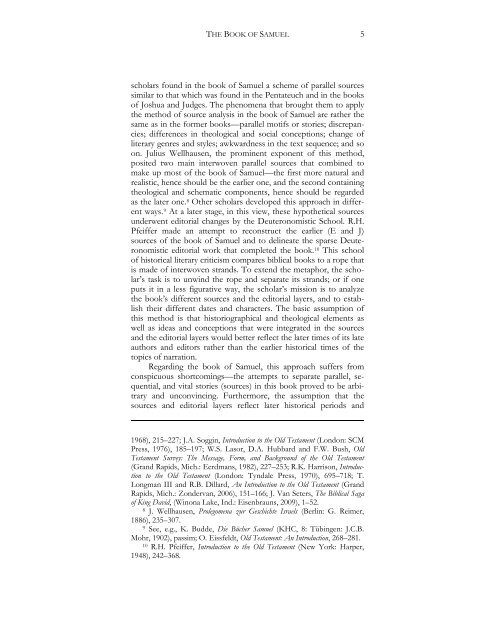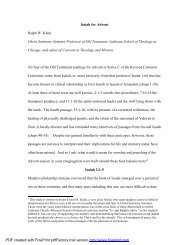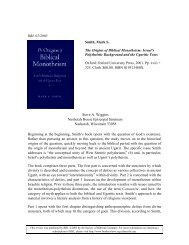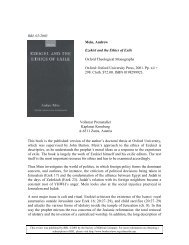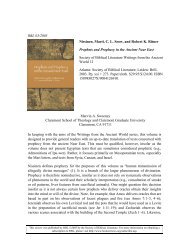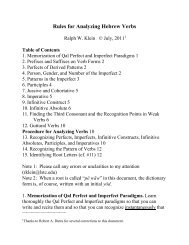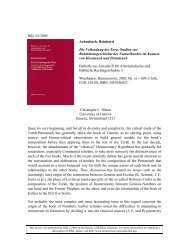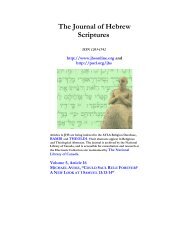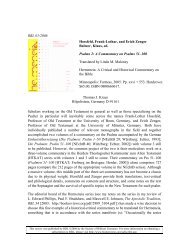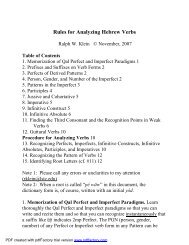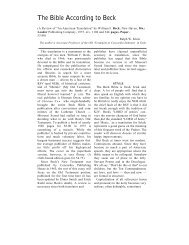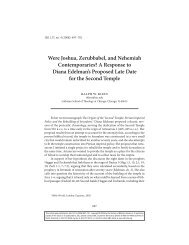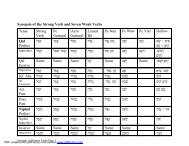The Book of Samuel: Its Composition, Structure and Significance as ...
The Book of Samuel: Its Composition, Structure and Significance as ...
The Book of Samuel: Its Composition, Structure and Significance as ...
Create successful ePaper yourself
Turn your PDF publications into a flip-book with our unique Google optimized e-Paper software.
THE BOOK OF SAMUEL<br />
scholars found in the book <strong>of</strong> <strong>Samuel</strong> a scheme <strong>of</strong> parallel sources<br />
similar to that which w<strong>as</strong> found in the Pentateuch <strong>and</strong> in the books<br />
<strong>of</strong> Joshua <strong>and</strong> Judges. <strong>The</strong> phenomena that brought them to apply<br />
the method <strong>of</strong> source analysis in the book <strong>of</strong> <strong>Samuel</strong> are rather the<br />
same <strong>as</strong> in the former books—parallel motifs or stories; discrepancies;<br />
differences in theological <strong>and</strong> social conceptions; change <strong>of</strong><br />
literary genres <strong>and</strong> styles; awkwardness in the text sequence; <strong>and</strong> so<br />
on. Julius Wellhausen, the prominent exponent <strong>of</strong> this method,<br />
posited two main interwoven parallel sources that combined to<br />
make up most <strong>of</strong> the book <strong>of</strong> <strong>Samuel</strong>—the first more natural <strong>and</strong><br />
realistic, hence should be the earlier one, <strong>and</strong> the second containing<br />
theological <strong>and</strong> schematic components, hence should be regarded<br />
<strong>as</strong> the later one. 8 Other scholars developed this approach in different<br />
ways. 9 At a later stage, in this view, these hypothetical sources<br />
underwent editorial changes by the Deuteronomistic School. R.H.<br />
Pfeiffer made an attempt to reconstruct the earlier (E <strong>and</strong> J)<br />
sources <strong>of</strong> the book <strong>of</strong> <strong>Samuel</strong> <strong>and</strong> to delineate the sparse Deuteronomistic<br />
editorial work that completed the book. 10 This school<br />
<strong>of</strong> historical literary criticism compares biblical books to a rope that<br />
is made <strong>of</strong> interwoven str<strong>and</strong>s. To extend the metaphor, the scholar’s<br />
t<strong>as</strong>k is to unwind the rope <strong>and</strong> separate its str<strong>and</strong>s; or if one<br />
puts it in a less figurative way, the scholar’s mission is to analyze<br />
the book’s different sources <strong>and</strong> the editorial layers, <strong>and</strong> to establish<br />
their different dates <strong>and</strong> characters. <strong>The</strong> b<strong>as</strong>ic <strong>as</strong>sumption <strong>of</strong><br />
this method is that historiographical <strong>and</strong> theological elements <strong>as</strong><br />
well <strong>as</strong> ide<strong>as</strong> <strong>and</strong> conceptions that were integrated in the sources<br />
<strong>and</strong> the editorial layers would better reflect the later times <strong>of</strong> its late<br />
authors <strong>and</strong> editors rather than the earlier historical times <strong>of</strong> the<br />
topics <strong>of</strong> narration.<br />
Regarding the book <strong>of</strong> <strong>Samuel</strong>, this approach suffers from<br />
conspicuous shortcomings—the attempts to separate parallel, sequential,<br />
<strong>and</strong> vital stories (sources) in this book proved to be arbitrary<br />
<strong>and</strong> unconvincing. Furthermore, the <strong>as</strong>sumption that the<br />
sources <strong>and</strong> editorial layers reflect later historical periods <strong>and</strong><br />
1968), 215–227; J.A. Soggin, Introduction to the Old Testament (London: SCM<br />
Press, 1976), 185–197; W.S. L<strong>as</strong>or, D.A. Hubbard <strong>and</strong> F.W. Bush, Old<br />
Testament Survey: <strong>The</strong> Message, Form, <strong>and</strong> Background <strong>of</strong> the Old Testament<br />
(Gr<strong>and</strong> Rapids, Mich.: Eerdmans, 1982), 227–253; R.K. Harrison, Introduction<br />
to the Old Testament (London: Tyndale Press, 1970), 695–718; T.<br />
Longman III <strong>and</strong> R.B. Dillard, An Introduction to the Old Testament (Gr<strong>and</strong><br />
Rapids, Mich.: Zondervan, 2006), 151–166; J. Van Seters, <strong>The</strong> Biblical Saga<br />
<strong>of</strong> King David, (Winona Lake, Ind.: Eisenbrauns, 2009), 1–52.<br />
8 J. Wellhausen, Prolegomena zur Geschichte Israels (Berlin: G. Reimer,<br />
1886), 235–307.<br />
9 See, e.g., K. Budde, Die Bücher <strong>Samuel</strong> (KHC, 8: Tübingen: J.C.B.<br />
Mohr, 1902), p<strong>as</strong>sim; O. Eissfeldt, Old Testament: An Introduction, 268–281.<br />
10 R.H. Pfeiffer, Introduction to the Old Testament (New York: Harper,<br />
1948), 242–368.<br />
5


